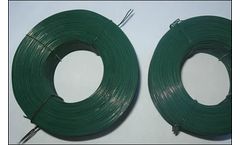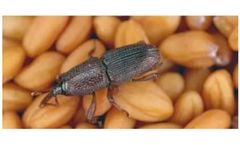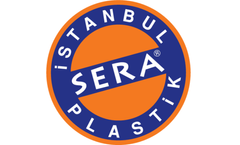Fumigant Articles & Analysis: Older
22 articles found
All rolls to be lightly oiled and wrapped pallets of the belt pack tie wire are stacked and bound with metal straps correctly. one piece per 64 boxes plastic pallets are more cost effective. supplied – packing declaration, fumigation certificate, etc. 0.5mm-2.5mm galvanized black annealed straight cut binding wire Black annealed tying wire Ø 3,8mm Tensile strength ...
Stomach Poisons: Insecticides are directly absorbed by the insects after being eaten by the gastrointestinal tract, causing them to be poisoned and die. Fumigants: Insecticides are vaporized from solid or liquid into gas, and enter the body through the respiratory system of the pest in a gaseous state, causing it to be poisoned and die. ...
Product packaging: It takes on professional fumigation-free packaging board, and also covers it with cling wrap to stop corrosion throughout transport. ...
Most of the time, Aluminium Phosphide is used for fumigation, though it can be dangerous. Also, insects and pests have developed resistance to phosphine. Other fumigants such as carbonyl sulfide, ethyl formate, hydrogen cyanide, methyl iodide, and propylene oxide have high costs compared to phosphine (Singh and Sharma 2015). ...
Common reasons for spoilage of stored cereals include water and humidity damage, invasion by insects or microorganisms, or even decomposition.3 Common approaches to kill invasive species were to fumigate storage silos with toxic chemicals4 but this only addresses the issue of damage by organisms and has become generally less popular with time due to concerns about the safety of ...
” Lane comments that the industry is really starting to see the after effects of the phase out of Methyl Bromide, a very effective soil fumigant which was definitely banned in 2016 for its proven toxic impact on human health and the environment. ...
Changes to pigs’ external environment, non-compliance or failures in the transport protocols or fumigation processes, and feeding stations rate as some of the most vulnerable spots in the pig farm. ...
The chemical does not engage irritating burning odor, unless the fumigation machine is overheated. It is safe and can be used in presence of human. Convenient to be used with Air Conditioner, it even disinfects its interior ducts and vents. Why Fumigation and not Spraying, Mopping or Wiping? There are chances of use chemical to come in physical contact during ...
Note that chemically treating wooden packing using Methyl Bromide fumigation still appears to be an acceptable form of treatment but has been banned in Europe since 2010 due to its harmful impact on the environment and cargo. ...
Methyl bromide is a is an odourless, colourlessgas most often used as a fumigant. About 70% of methylbromide produced in the United States goes into pesticidal formulations. It has been used to fumigate agricultural commodities, grain elevators, mills, ships, clothes, furniture greenhouses and delicate works of art. ...
Ecosystems provide the conditions for producing food, regulating water, and providing wildlife habitats; these, among others, are known as ecosystem services (ESs). Food production is both economically and culturally important to southern European farmers, particularly in Italy where farmers grow flavorsome tomatoes with passion and pride. Growers rely on pesticides for crop protection, the ...
Environmental Protection Agency (EPA) completed a significant review of registered fumigant products as part of its reregistration program, pursuant to which EPA required expansive label changes and new study requirements for many fumigants. ...
Fungi in strawberries has grown to become a monumental issue, so much so that large growers have to fumigate their entire crop to safeguard it. Fumigants are inherently dangerous pesticides that are often linked with accidental mass poisonings. Even when accidents do not occur, fumigant application expose people to unsafe levels of toxic ...
The most common treatment currently available to prevent these infections and maintain fruit quality is to fumigate with SO2 and use metabisulphite. Whilst these treatments are effective, they present a number of inconveniences: Development of stains and decolouring of fruit. ...
This period can be increased up to 8-10 weeks to prevent some diseases which are living in the depths of the soil. Also, low or half fumigants doses of some applied methods should be combined. 9- Once the application is ended, new soil is very sensitive to be infected by microorganisms because of partial sterilization. ...
The following treatments were applied to clean soil: 1) a mixture of the pesticides chlorothalonil, S‐metolachlor, metribuzin, and chlorpyrifos, and 2) the soil fumigant metam sodium. Turtle eggs were incubated in soil in outdoor plots in which these mixtures were applied at typical and higher field application rates, where the eggs were subject to ambient temperature and weather ...
Thus, the oils could be recommended as botanical fumigants after a long-term and wide range of trials.Keywords: Botryodiplodia theobromae, essential oils, fungicides, fungitoxicity, geranium, mint, palmarosa, postharvest diseases, stem end rot, thyme, essential oils, postharvest control, mango fruits, fruit storage, shelf life, botanical ...
Field assessment with native population allowed the detection of dead anuran larvae of the species present in the stream of water after fumigation, in coincidence with the decrease in the frequency of live larvae (p Keywords: anuran, tadpoles, soya bean production, soya beans, endosulphan, cypermethrin, acute toxicity, Hypsiboas pulchellus, Rhinella fernandezae, Leptodactylus ...
Before planting pepper, plots rotated from cotton were fumigated with 1,3-dichloropropene (1,3-D) for nematode suppression according to standard practice. ...
The study was conducted in 2002 and 2004; in each year, new plots were fumigated and then sprigged with Tifway and TifSport. Nitrogen source treatments were ammonium nitrate (AN) (34-0-0) or calcium (Ca) nitrate (CaN) (16-0-0; 39% Ca), both applied at 2.4, 4.9, 7.3, or 9.8 g N m–2 wk–1. ...

















